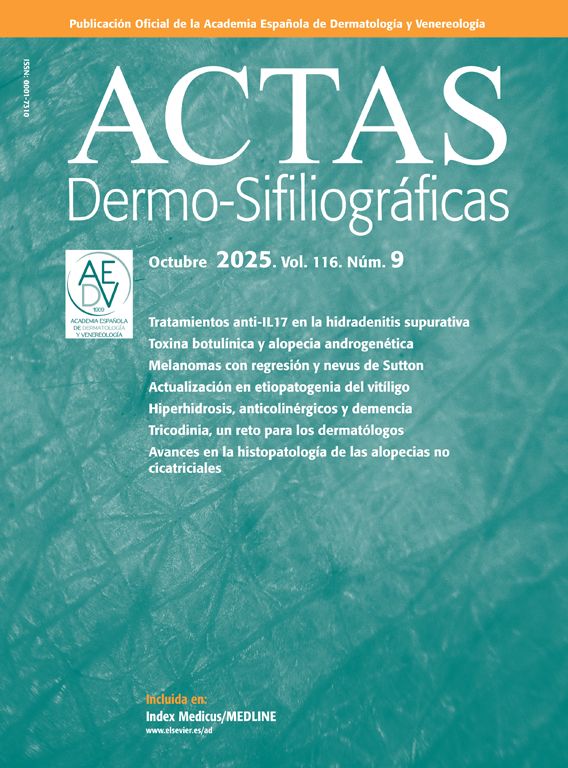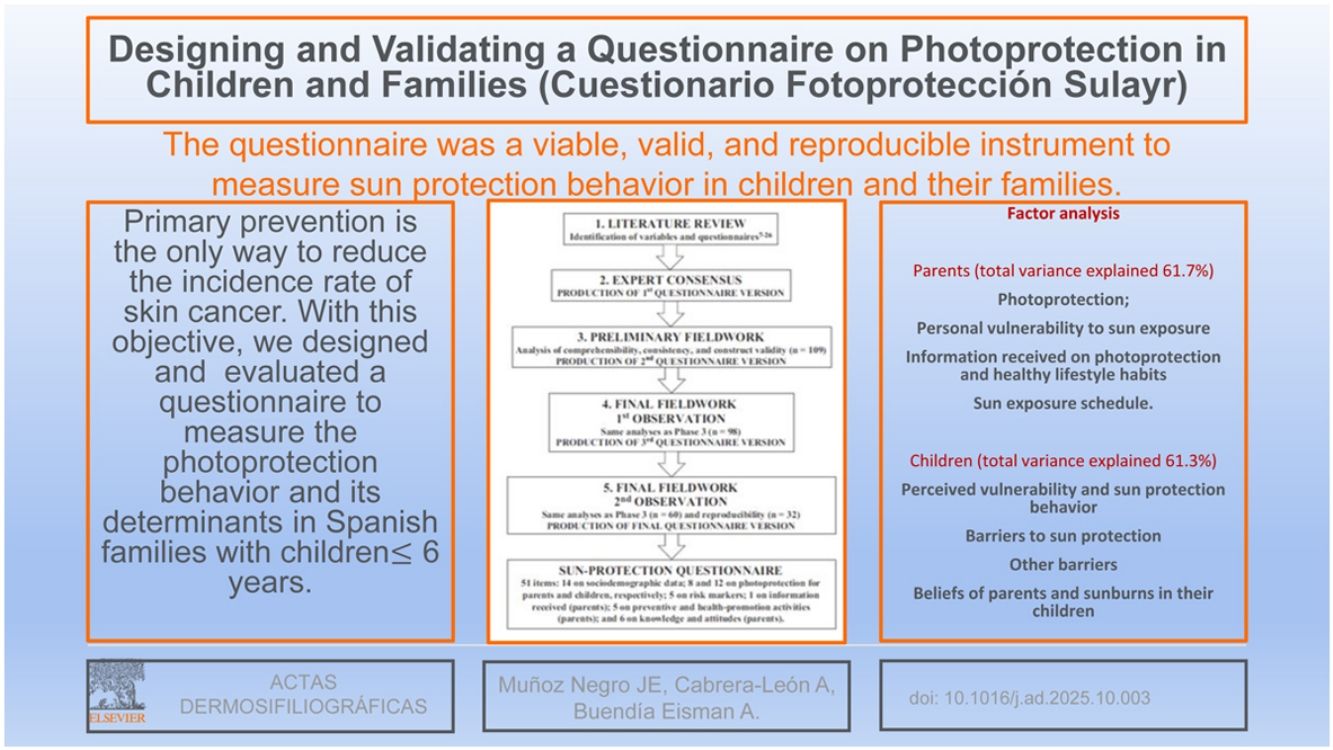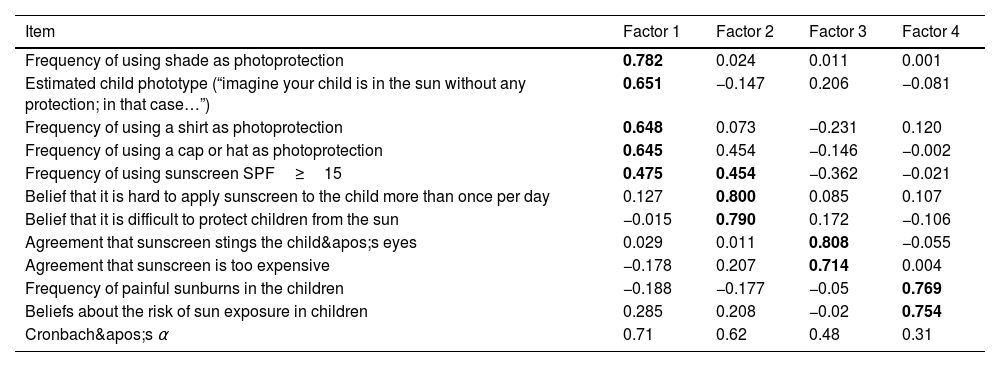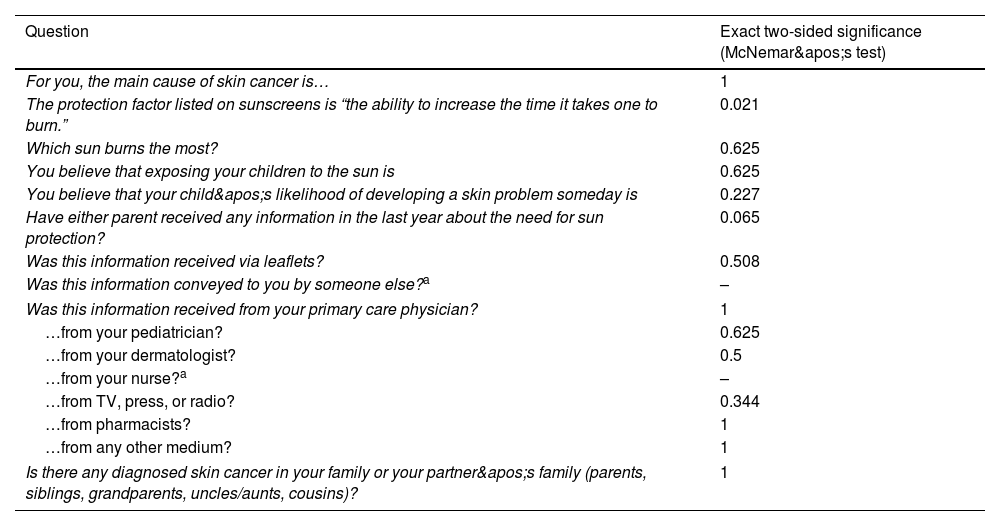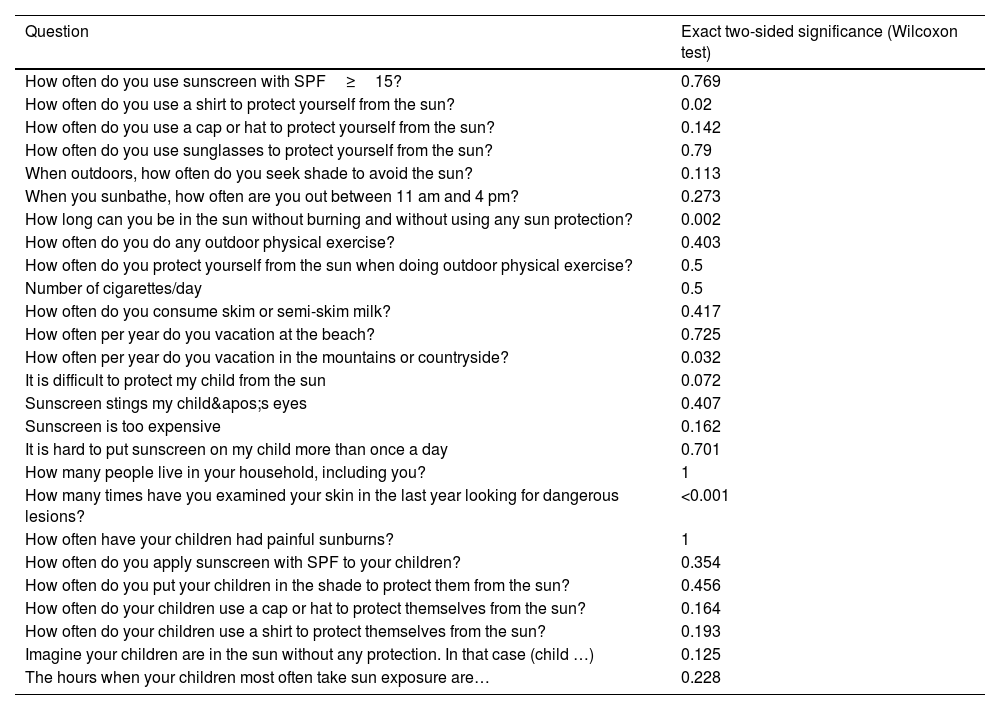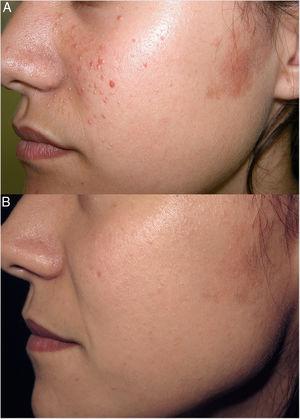Primary prevention is the only way to reduce the incidence rate of skin cancer. With this objective, we designed and evaluated the questionnaire's feasibility, validity, and reproducibility on photoprotective behaviors and their associated variables in the child population and their families.
Material and methodsAfter reviewing the literature, a group of experts drafted the first questionnaire, analyzing its logical and content validity in 109 participants. A new questionnaire was obtained from this analysis, examining its internal validity through factor analysis and internal consistency (n=98). Finally, reproducibility was determined in 32 participants who had previously answered the questionnaire.
ResultsOur questionnaire was easy or very easy for 75% of the study population (mean time, 12min). The following 4 factors were obtained for parents (total explained variance=61.7%): “photoprotection of fathers and mothers”; “personal vulnerability to sun exposure”; “information received on photoprotection and healthy lifestyle habits,” and “sun exposure schedule”. For children, a total of 4 factors were also obtained (variance=61.3%): “perceived vulnerability and sun protection behavior”; “barriers to sun protection”; “other barriers”; and “beliefs of mothers and fathers and sunburns in their children”. On the other hand, significant changes were only observed in 5 questions. The results of each fieldwork produced improved versions of the questionnaire until its final version was obtained.
ConclusionThe questionnaire was a viable, valid, and reproducible instrument to measure sun protection behavior in children and their families.
La prevención primaria es el único modo de disminuir la incidencia del cáncer de piel. Con ese objetivo diseñamos y evaluamos la viabilidad, validez y reproducibilidad de un cuestionario sobre conductas fotoprotectoras y sus variables asociadas en la población infantil y en sus familias.
Material y métodosTras revisar la literatura, un grupo de expertos redactó un primer cuestionario, analizándose su validez lógica y de contenido en 109 participantes. A partir de este análisis se obtuvo un nuevo cuestionario, analizándose su validez interna mediante análisis factorial y de consistencia interna (n=98). Finalmente, se determinó la reproducibilidad en 32 participantes que habían contestado previamente el cuestionario.
ResultadosNuestro cuestionario resultó fácil o muy fácil para el 75% de la población de estudio (tiempo medio 12minutos). Se obtuvieron los siguientes 4 factores para los padres (varianza total explicada=61.7%): «fotoprotección de padres y madres», «vulnerabilidad personal hacia la exposición solar», «información recibida sobre fotoprotección y hábitos de vida sana» y «horario de exposición solar». Para hijos/as se obtuvieron también 4 factores (varianza=61,3%): «vulnerabilidad percibida y conducta fotoprotectora»; «barreras frente a la fotoprotección»; «otras barreras»; y «creencias de madres y padres y quemaduras en sus hijas/os». Por otra parte, solo se observó cambio significativo en 5 preguntas. Los resultados de cada trabajo de campo nos sirvieron para producir versiones mejoradas del cuestionario, hasta obtener su versión definitiva.
ConclusiónEl cuestionario resultó ser un instrumento viable, válido y reproducible para medir la conducta fotoprotectora en la infancia y sus familias.
Skin cancer is the most common group of malignant neoplasms in light-skinned populations worldwide. Owing to environmental and social factors, its incidence rate has increased over recent decades.1
Primary prevention of skin cancer, together with early detection, is the most effective tool available to control the problem.2 This prevention should start in childhood, where photoprotective behaviors play a key role.3 For this reason, it is crucial to have an instrument that measures photoprotective behavior in childhood. Various tools exist (e.g., direct observation, photographs, or diaries), with questionnaires being the most widely used and recognized method in the international literature.
Questionnaires—validated for measuring photoprotective behaviors and sun exposure—offer several advantages over other measurement instruments, chief among them feasibility (they allow reaching a large number of participants quickly and at low cost).4 Two Spanish-language questionnaires on habits, knowledge, and attitudes regarding photoprotection in children and young adults have been validated recently.5,6 However, no validated questionnaires are available to assess photoprotection and its related variables in the pediatric population and their families.
Accordingly, the objective of this study was to design and evaluate the feasibility, validity, and reproducibility of a questionnaire on photoprotective behavior in children and their families.
MethodsDesignValidation study with an observational design and 3 cross-sectional measurements (1 for the preliminary fieldwork and 2 for the definitive phase), with a longitudinal subsample in the second and third measurements for reproducibility analysis.
Study populationThe study was conducted in 3 randomly selected early-childhood education centers in the city of Granada (Spain). Within each center, the study was offered to all children aged≤6 years.
Questionnaire design and validationThe questionnaire design and validation proceeded in the following phases (Fig. 1):
- 1.
Literature review. Conducted for 1986–2015 in MEDLINE and Índice Médico Español using the keywords: skin cancer, primary prevention, questionnaire, knowledge, behaviors, attitudes, risk factors, photoprotection, sunburn, and preschool. Variables associated with photoprotection use in childhood were identified, as well as internationally accepted questionnaires on the topic.7–26 The findings informed the next phase.
- 2.
Expert panel of the Cutaneous Oncology Group, School of Medicine of Universidadde Granada, to determine content validity and develop the first questionnaire version.
- 3.
Preliminary fieldwork, carried out in 2 schools (n=109; 51.9% response). We analyzed completion time, comprehensibility, internal consistency, and construct validity. Based on these results, we modified content, structure, and format, producing an improved version for the next phase.
- 4.
Definitive fieldwork, first observation, conducted in a third school (n=98; 46.7% response). The same analyses were performed as in the previous phase.
- 5.
Definitive fieldwork, second observation, conducted 3 months later in the same school year and population (n=60). We repeated the prior analyses and additionally assessed questionnaire reproducibility in the subsample that also responded in the first observation (n=32). These results completed the validation study and yielded the final questionnaire (Supplementary data).
The questionnaire comprises 51 items with information about mothers, fathers, and children. It was developed from findings at each phase and contains the following sections:
- 1.
Demographics (14 items): household members and usual occupation; sex and age of respondent; marital status; educational level, profession, and employment status of mother and father; age and sex of up to 3 children aged≤6 years (3 items).
- 2.
Parental photoprotection (8 Likert-scale items): use of sunscreens and other sun-protective measures, as well as history and severity of sunburns.
- 3.
Children's photoprotection (12 items): degree of agreement regarding sunscreen use (4 ordinal items), use of sunscreens and other sun-protective measures (4 Likert items), frequency of sunburns (one Likert item), number of blistering sunburns (one item), sun-exposure habits (1 item with 5 categories and another item on exposure times).
- 4.
Risk markers (5 items): propensity to sunburn (1 item for parents and 3 for children; 6 categories) and family history of skin cancer (1 dichotomous item, yes/no).
- 5.
Information received by parents about photoprotection (1 item with 10 categories).
- 6.
Preventive and health-promotion activities by parents (5 items): healthy lifestyle habits (2 ordinal items with 4 categories on physical activity and tobacco; 2 Likert items on consumption of non-whole milk and seat-belt use) and frequency of skin self-examination (1 item).
- 7.
Knowledge and attitudes about sun exposure (6 items): attitude toward tanning (1 item, 3 categories); skin cancer and its relationship with sun exposure (1 item, 6 categories); hours of highest solar radiation (1 item, 7 categories); place of greatest sun exposure (1 item, 5 categories); consequences of sun exposure (2 ordinal items, 5 categories).
In all fieldwork phases we performed descriptive analyses of the information blocks and questions in each questionnaire version; item and scale performance (Pearson and Spearman correlations depending on variable type); construct validity (exploratory factor analysis on principal components with varimax rotation, assessing model adequacy with Kaiser's criterion and Bartlett's test of sphericity); internal consistency (Cronbach's α); and, in the second observation only, reproducibility analysis (test–retest for qualitative variables using McNemar's test and proportions of agreement/change, and for quantitative variables using the Wilcoxon test; exact, two-sided tests for small samples). Analyses were performed separately for the items addressed to parents and for those addressed to their children. The significance level was set at 0.05. Statistical analyses used SPSS software (version 20.0; IBM Corp., Somers, NY).
ResultsDescription of the study samplesTable 1 describes the most significant sociodemographic variables. Statistically significant differences were observed in the percentage of participating women, which was higher in the first observation (p<0.045), and in the percentage of parents with university studies in both observations (p<0.01).
Distribution of study samples.
| Sociodemographic variables | Preliminary fieldwork | Final fieldwork: 1st observation | Final fieldwork: 2nd observation |
|---|---|---|---|
| Sex of respondent | |||
| Woman | 77% | 91.9% | 85% |
| Man | 23% | 8.1% | 15% |
| Mean household size | 4 | 4.2 | 4.3 |
| Mean age | |||
| Mother | 36.5 | 36.6 | 36.4 |
| Father | 38.8 | 38.7 | 38.9 |
| University education | |||
| Mother | 58.3% | 72.4% | 70.3% |
| Father | 48.1% | 80.4% | 78.8% |
| Sample | 109 | 98 | 60 |
The questionnaire was rated easy or very easy by 75.2% of participants and difficult or very difficult by 1.8%. Overall, 63.6% completed it in 10minutes or less (mean, 12minutes; 95%CI, 10.8–13.2).
Internal validity of the questionnaire (definitive fieldwork)Based on the factor analysis in the first observation, 4 factors were identified for the parent items and another 4 for the child items.
For the parent items, communalities were high, ranging from 0.56 to 0.71. The total variance explained by the model was 61.7%, yielding the following four factors (Table 2):
- 1.
Parental photoprotection: questions on the frequency with which parents use sunscreen with SPF>15, shirts, sunglasses, hats, and shade; these behaviors cluster together. Owing to low communality, the question on using sunglasses for sun protection was removed (it contributed little to explaining variability), which improved the factor's internal consistency. This factor alone explained 21.4% of model variance.
- 2.
Personal vulnerability to sun exposure: composed of “frequency of blistering sunburns” and “time able to stay in the sun without protection before burning.”
- 3.
Information received on photoprotection and healthy lifestyle habits: questions on parents’ health habits: “habit of outdoor exercise,” “consumption of skim milk,” and “degree of information on health and sun exposure.”
- 4.
Sun-exposure schedule: the question “frequency of sun exposure from 11:00 to 16:00,” which behaved independently of the other factors.
Factor analysis, mothers and fathers (1st observation).
| Item | Factor 1 | Factor 2 | Factor 3 | Factor 4 |
|---|---|---|---|---|
| Frequency of using a shirt | 0.732 | −0.27 | −0.005 | 0.208 |
| Frequency of using a cap or hat | 0.699 | 0.02 | −0.149 | −0.331 |
| Frequency of using sunscreen with SPF≥15 | 0.691 | 0.184 | 0.227 | 0.020 |
| Frequency of using shade outdoors | 0.544 | −0.41 | −0.071 | 0.351 |
| Frequency of blistering sunburns | −0.02 | 0.760 | 0.003 | 0.040 |
| Estimated time you can be in the sun without burning | 0.00 | 0.752 | −0.115 | 0.048 |
| Frequency of consuming semi-skim or skim milk | 0.120 | −0.15 | 0.763 | −0.307 |
| Channels through which you received photoprotection information | 0.101 | 0.177 | 0.652 | 0.466 |
| Frequency of outdoor physical exercise | −0.461 | −0.17 | 0.568 | −0.06 |
| Frequency of sun exposure between 11:00am and 4:00pm | 0.019 | 0.04 | −0.102 | 0.777 |
| Cronbach's α | 0.63 | 0.44 | 0.30 | – |
Extraction method: principal component analysis. Rotation method: Varimax normalization with Kaiser. Total variance explained: 61.7% (the bolded loading corresponds to the items comprising each factor).
For the child items, communalities were slightly lower than for parents, ranging from 0.493 to 0.694. The total variance explained was very similar (61.3%), yielding these four factors (Table 3):
- 1.
Perceived vulnerability and photoprotective behavior: use of sunscreen, shirts, hats, and shade by children, plus the child's phototype.
- 2.
Barriers to photoprotection: “it is hard to apply photoprotection more than once a day” and “photoprotection is difficult.”
- 3.
Other barriers to photoprotection: “photoprotection is expensive” and “photoprotection stings the eyes.”
- 4.
Parental beliefs and burns in their children: parental belief (positive or negative) about the risks of sun exposure for their children, and the frequency with which their children have had painful sunburns.
Factor analysis, children (1st observation).
| Item | Factor 1 | Factor 2 | Factor 3 | Factor 4 |
|---|---|---|---|---|
| Frequency of using shade as photoprotection | 0.782 | 0.024 | 0.011 | 0.001 |
| Estimated child phototype (“imagine your child is in the sun without any protection; in that case…”) | 0.651 | −0.147 | 0.206 | −0.081 |
| Frequency of using a shirt as photoprotection | 0.648 | 0.073 | −0.231 | 0.120 |
| Frequency of using a cap or hat as photoprotection | 0.645 | 0.454 | −0.146 | −0.002 |
| Frequency of using sunscreen SPF≥15 | 0.475 | 0.454 | −0.362 | −0.021 |
| Belief that it is hard to apply sunscreen to the child more than once per day | 0.127 | 0.800 | 0.085 | 0.107 |
| Belief that it is difficult to protect children from the sun | −0.015 | 0.790 | 0.172 | −0.106 |
| Agreement that sunscreen stings the child's eyes | 0.029 | 0.011 | 0.808 | −0.055 |
| Agreement that sunscreen is too expensive | −0.178 | 0.207 | 0.714 | 0.004 |
| Frequency of painful sunburns in the children | −0.188 | −0.177 | −0.05 | 0.769 |
| Beliefs about the risk of sun exposure in children | 0.285 | 0.208 | −0.02 | 0.754 |
| Cronbach's α | 0.71 | 0.62 | 0.48 | 0.31 |
Extraction method: principal component analysis. Rotation method: Varimax normalization with Kaiser. Total variance explained: 61.3% (the bolded loading corresponds to the items comprising each factor).
Using the second-observation sample, factor analysis again yielded 4 parent factors, virtually identical to the first observation, and 3 child factors, in which the previous Factors 2 and 3 merged into a single factor with improved internal consistency (Cronbach's α=0.71).
Reproducibility of the questionnaire (1st and 2nd observations)Only 5 questions showed statistically significant response changes between the 1st and 2nd observations, particularly those related to skin self-examination (p<0.001) and time in the sun without burning (p=0.002) (Tables 4 and 5).
Reproducibility of the questionnaire (qualitative variables).
| Question | Exact two-sided significance (McNemar's test) |
|---|---|
| For you, the main cause of skin cancer is… | 1 |
| The protection factor listed on sunscreens is “the ability to increase the time it takes one to burn.” | 0.021 |
| Which sun burns the most? | 0.625 |
| You believe that exposing your children to the sun is | 0.625 |
| You believe that your child's likelihood of developing a skin problem someday is | 0.227 |
| Have either parent received any information in the last year about the need for sun protection? | 0.065 |
| Was this information received via leaflets? | 0.508 |
| Was this information conveyed to you by someone else?a | – |
| Was this information received from your primary care physician? | 1 |
| …from your pediatrician? | 0.625 |
| …from your dermatologist? | 0.5 |
| …from your nurse?a | – |
| …from TV, press, or radio? | 0.344 |
| …from pharmacists? | 1 |
| …from any other medium? | 1 |
| Is there any diagnosed skin cancer in your family or your partner's family (parents, siblings, grandparents, uncles/aunts, cousins)? | 1 |
a 100% of individuals answered “no” both before and after.
Reproducibility of the questionnaire (quantitative variables).
| Question | Exact two-sided significance (Wilcoxon test) |
|---|---|
| How often do you use sunscreen with SPF≥15? | 0.769 |
| How often do you use a shirt to protect yourself from the sun? | 0.02 |
| How often do you use a cap or hat to protect yourself from the sun? | 0.142 |
| How often do you use sunglasses to protect yourself from the sun? | 0.79 |
| When outdoors, how often do you seek shade to avoid the sun? | 0.113 |
| When you sunbathe, how often are you out between 11 am and 4 pm? | 0.273 |
| How long can you be in the sun without burning and without using any sun protection? | 0.002 |
| How often do you do any outdoor physical exercise? | 0.403 |
| How often do you protect yourself from the sun when doing outdoor physical exercise? | 0.5 |
| Number of cigarettes/day | 0.5 |
| How often do you consume skim or semi-skim milk? | 0.417 |
| How often per year do you vacation at the beach? | 0.725 |
| How often per year do you vacation in the mountains or countryside? | 0.032 |
| It is difficult to protect my child from the sun | 0.072 |
| Sunscreen stings my child's eyes | 0.407 |
| Sunscreen is too expensive | 0.162 |
| It is hard to put sunscreen on my child more than once a day | 0.701 |
| How many people live in your household, including you? | 1 |
| How many times have you examined your skin in the last year looking for dangerous lesions? | <0.001 |
| How often have your children had painful sunburns? | 1 |
| How often do you apply sunscreen with SPF to your children? | 0.354 |
| How often do you put your children in the shade to protect them from the sun? | 0.456 |
| How often do your children use a cap or hat to protect themselves from the sun? | 0.164 |
| How often do your children use a shirt to protect themselves from the sun? | 0.193 |
| Imagine your children are in the sun without any protection. In that case (child …) | 0.125 |
| The hours when your children most often take sun exposure are… | 0.228 |
Currently, there is no measurement method for photoprotective behavior that can be considered a “gold standard.”4 Moreover, few studies assess the validity and reproducibility of questionnaires measuring photoprotection and its associated variables,7 and available studies are difficult to compare owing to contextual and methodological differences.8
Our questionnaire showed good feasibility: it was easy to complete and brief—well below the 30–40min some authors recommend as an upper limit.26 It contains more questions than some similar works because it captures more information,9–11 although its total number of items is similar to other reports.27
Regarding internal validity, we observed a clear, logical construct. Notably, parental photoprotective measures clustered into an independent factor with good internal consistency, except for the use of sunglasses and avoidance of sun exposure at peak-radiation hours. The study population appears not to view sunglasses as a photoprotective measure but rather as esthetic or for comfort. Avoiding sun exposure at peak hours was the least used measure, indicating ample room for improvement. The factor “information received on photoprotection and healthy lifestyle habits” reflects a logical association between photoprotection and other healthy behaviors.
For the child items, the construct was also solid. A low phototype associated with more photoprotective behavior, a finding widely reported.9–15 As with parents, child photoprotective measures clustered together. Grouping of sunburns in children with the belief that the sun is dangerous suggests parents infer sun danger from their children's burn experience—an important psychosocial variable for prevention campaigns. It is therefore necessary to emphasize that the sun is dangerous even without a family history of sunburn. Barriers to photoprotection split into 2 independent factors—“hard/difficult” versus “stings the eyes/expensive”—which merged into 1 factor in the 2nd observation, further supporting the questionnaire's validity.
Questionnaire reproducibility was adequate. The resulting final version has been used in epidemiologic studies such as the Andalusian Health Survey since 2007,28 a key population-based source on the health status of Andalusians and their health system, and in other research projects.29,30 Its good reproducibility has also allowed its use to evaluate educational campaigns conducted by our research group.31,32
Study limitations include potential selection bias (volunteer parents may be more concerned about health and photoprotection than the general population); differences in parental university education between samples (reflecting socioeconomic differences among schools across study phases); a small reproducibility sample with low statistical power; and social desirability bias inherent to questionnaire studies.14,27
ConclusionsWe developed a feasible, valid, and reproducible instrument to assess photoprotective behavior and its related variables in children and their families.
Research ethicsParticipants provided informed consent to take part in this fully voluntary study, which complied with the principles set forth in the Declaration of Helsinki.
FundingNone declared.
Conflicts of interestNone declared.
We thank the families and staff of Cristo de la Yedra, Santo Tomás de Villanueva, and Nazaret schools for their collaboration in the study.
